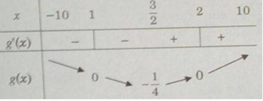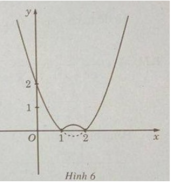giá trị nhỏ nhất của hàm số f(x)=\(x+\dfrac{1}{x-1}\) (x>1)
A.3 B.1 C.4 D.5
Hãy nhập câu hỏi của bạn vào đây, nếu là tài khoản VIP, bạn sẽ được ưu tiên trả lời.

a.
\(y=\dfrac{4}{x}+\dfrac{1}{1-x}-1\ge\dfrac{\left(2+1\right)^2}{x+1-x}-1=8\)
\(y_{min}=8\) khi \(x=\dfrac{4}{5}\)
b.
\(y=\dfrac{1}{x}+\dfrac{1}{1-x}\ge\dfrac{4}{x+1-x}=4\)
\(y_{min}=4\) khi \(x=\dfrac{1}{2}\)

bạn thử tải app này xem có đáp án không nhé <3 https://giaingay.com.vn/downapp.html
a/ \(A=\frac{x}{2}+\frac{1}{2x}+\frac{5x}{2}\ge2\sqrt{\frac{x}{4x}}+\frac{5}{2}.1=\frac{7}{2}\)
\("="\Leftrightarrow x=1\)
b/ \(B=\frac{3\left(x+1\right)}{2}+\frac{1}{x+1}-\frac{3}{2}\ge2\sqrt{\frac{3\left(x+1\right)}{2\left(x+1\right)}}-\frac{3}{2}=\frac{-3+2\sqrt{6}}{2}\)
\("="\Leftrightarrow\left(x+1\right)^2=\frac{2}{3}\Rightarrow x=...\)
c/ \(C=\frac{2x-1}{6}+\frac{5}{2x-1}+\frac{1}{6}\ge2\sqrt{\frac{5\left(2x-1\right)}{6\left(2x-1\right)}}+\frac{1}{6}=\frac{1+2\sqrt{30}}{6}\)
\("="\Leftrightarrow\left(2x-1\right)^2=30\Rightarrow x=...\)
d/ \(D=x+\frac{4}{x}+4\ge2\sqrt{\frac{4x}{x}}+4=8\)
\("="\Leftrightarrow x^2=4\Rightarrow x=...\)
e/ \(E=\left(x+3\right)\left(5-x\right)\le\frac{1}{4}\left(x+3+5-x\right)^2=16\)
\("="\Leftrightarrow x+3=5-x\Rightarrow x=...\)
f/ \(F=\frac{1}{2}\left(2x+6\right)\left(5-2x\right)\le\frac{1}{8}\left(2x+6+5-2x\right)^2=\frac{121}{8}\)
\("="\Leftrightarrow2x+6=5-2x\Leftrightarrow x=...\)

Câu 1:
a)
| \(y=f\left(x\right)=2x^2\) | -5 | -3 | 0 | 3 | 5 |
| f(x) | 50 | 18 | 0 | 18 | 50 |
b) Ta có: f(x)=8
\(\Leftrightarrow2x^2=8\)
\(\Leftrightarrow x^2=4\)
hay \(x\in\left\{2;-2\right\}\)
Vậy: Để f(x)=8 thì \(x\in\left\{2;-2\right\}\)
Ta có: \(f\left(x\right)=6-4\sqrt{2}\)
\(\Leftrightarrow2x^2=6-4\sqrt{2}\)
\(\Leftrightarrow x^2=3-2\sqrt{2}\)
\(\Leftrightarrow x=\sqrt{3-2\sqrt{2}}\)
hay \(x=\sqrt{2}-1\)
Vậy: Để \(f\left(x\right)=6-4\sqrt{2}\) thì \(x=\sqrt{2}-1\)

\(f'\left(x\right)=1-\dfrac{1}{x^2}=\dfrac{x^2-1}{x^2}>0;\forall x\ge2\)
\(\Rightarrow f\left(x\right)\) đồng biến
\(\Rightarrow f\left(x\right)_{min}=f\left(2\right)=\dfrac{5}{2}\)

a) 
f′(x) > 0 trên khoảng (-4; 0) và f’(x) < 0 trên khoảng (0; 4).
Hàm số đạt cực đại tại x = 0 và f C Đ = 5
Mặt khác, ta có f(-4) = f(4) = 3
Vậy 
d) f(x) = | x 2 − 3x + 2| trên đoạn [-10; 10]
Khảo sát sự biến thiên và vẽ đồ thị của hàm số g(x) = x 2 – 3x + 2.
Ta có:
g′(x) = 2x − 3; g′(x) = 0 ⇔ x = 3/2
Bảng biến thiên:

Vì

nên ta có đồ thị f(x) như sau:

Từ đồ thị suy ra: min f(x) = f(1) = f(2) = 0; max = f(x) = f(−10) = 132
e) 
f′(x) < 0 nên và f’(x) > 0 trên (π/2; 5π/6] nên hàm số đạt cực tiểu tại x = π/2 và f C T = f(π/2) = 1
Mặt khác, f(π/3) = 2√3, f(5π/6) = 2
Vậy min f(x) = 1; max f(x) = 2
g) f(x) = 2sinx + sin2x trên đoạn [0; 3π/2]
f′(x) = 2cosx + 2cos2x = 4cos(x/2).cos3(x/2)
f′(x) = 0
⇔ 
Ta có: f(0) = 0,

Từ đó ta có: min f(x) = −2 ; max f(x) = 3√3/2

a: ĐKXĐ: \(m\le5\)
b: ĐKXĐ: \(m\notin\left\{-1;1\right\}\)
c: ĐKXĐ: \(m\ne-2\)

\(A=\left|\dfrac{3}{5}-x\right|+\dfrac{1}{9}\ge\dfrac{1}{9}\\ A_{min}=\dfrac{1}{9}\Leftrightarrow x=\dfrac{3}{5}\\ B=\dfrac{2009}{2008}-\left|x-\dfrac{3}{5}\right|\le\dfrac{2009}{2008}\\ B_{max}=\dfrac{2009}{2008}\Leftrightarrow x=\dfrac{3}{5}\\ C=-2\left|\dfrac{1}{3}x+4\right|+1\dfrac{2}{3}\le1\dfrac{2}{3}\\ C_{max}=1\dfrac{2}{3}\Leftrightarrow\dfrac{1}{3}x=-4\Leftrightarrow x=-12\)
\(f\left(x\right)=x+\dfrac{1}{x-1}=x-1+\dfrac{1}{x-1}+1\ge2\sqrt{\left(x-1\right).\dfrac{1}{x-1}}+1=3\)
\(\Leftrightarrow f\left(x\right)\ge3\). \("="\Leftrightarrow x-1=\dfrac{1}{x-1}\Leftrightarrow\left(x-1\right)^2=1\Leftrightarrow x=2\left(x>1\right)\)
Đáp án A